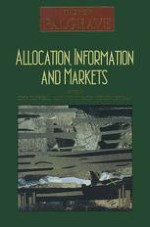1989 | OriginalPaper | Buchkapitel
Experimental Methods in Economics
verfasst von : Vernon L. Smith
Erschienen in: Allocation, Information and Markets
Verlag: Palgrave Macmillan UK
Enthalten in: Professional Book Archive
Aktivieren Sie unsere intelligente Suche, um passende Fachinhalte oder Patente zu finden.
Wählen Sie Textabschnitte aus um mit Künstlicher Intelligenz passenden Patente zu finden. powered by
Markieren Sie Textabschnitte, um KI-gestützt weitere passende Inhalte zu finden. powered by
Historically, the method and subject matter of economics have presupposed that it was a non-experimental (or ‘field observational’) science more like astronomy or meteorology than physics or chemistry. Based on general, introspectively ‘plausible’, assumptions about human preferences, and about the cost and technology-based supply response of producers, economists have sought to understand the functioning of economies, using observations generated by economic outcomes realized over time. The data of the astronomer is of this same type, but it would be wrong to conclude that astronomy and economics are methodologically equivalent. There are two important differences between astronomy and economics which help to illuminate some of the methodological problems of economics. First, based upon parallelism (the maintained hypothesis that the same physical laws hold everywhere), astronomy draws on all the relevant theory from classical mechanics and particle physics — theory which has evolved under rigorous laboratory tests. Traditionally, economists have not had an analogous body of tested behavioural principles that have survived controlled experimental tests, and which can be assumed to apply with insignificant error to the microeconomic behaviour that underpins the observable operations of the economy. Analogously, one might have supposed that there would have arisen an important area of common interest between economics and, say, experimental psychology, similar to that between astronomy and physics, but this has only started to develop in recent years.
